|
ARTIFACT
“I don’t find the purely virtual terribly exciting, just as in the same way, I don’t find the purely real terribly exciting. I like to see what happens when the two collide – the tensions that are created between them.” – Bernard Tschumi
Architecture has actually experienced an evolution throughout history in terms of “dimension” (D). There are 4 stages, all still exist nowadays, resembling that of movies: 2D, 3D, 4D, and a 4Dx that I propose.
Architecture as (Media) “Dimension” Mediates
BOOK 2D TEXTS
SCREEN 2D TEXTS + IMAGES
FILM 3D TEXTS +IMAGES + SOUND + PLOT
CINEMA 3D VISUAL ILLUSIONS + AUDIENCE
CINEMA 4D STIMULATION OF SENSES
? 4Dx VIRTUAL SPACE + REAL BODY
The design focus of the above “Dimension” architecture is actually dimensionless in terms of real space. The space in 4Dx architecture happens in the mind (virtual space), when body senses are stimulated. The x appears when mutation occurs between the limitation in body sensations and the infinity in imagination. My concept is that architecture is not about designing real space, but designing the stimulation or mechanism that triggers the x mutation.
4Dx GENERATION:
Architecture Without Actual Space
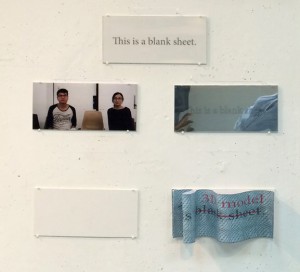
The Mutated Perceptions
Cheryl Cecilia Lui
* Animation link:
https://drive.google.com/folderview?id=0B5yB4bkw1p7fZFRncnNmdkFPclU&usp=sharing
Actual, Projected (Artificial-static), Projected (Natural-changing), Projected (Artificial-changing), Mutation
(Top to bottom, left to right)
A set of experimentation diagrams using metaphorical method to investigate a philosophical theory on human perceptions. Referencing Plato’s analogy of the cave and Henri Bergson’s concept on perception, this first experiment is claiming the virtual being real, and that surfaces being dimensionless. The shifting of the audience’s point of perception across the actual and virtual,actually is an additional factor which changes the perceived. Seeing architecture as a “cinema” instead of a “film” means the audience is included in the design as well. The manipulation of the audience’s perception and the mutation of sensations, contribute to the content actively instead of passively.
WHAT?
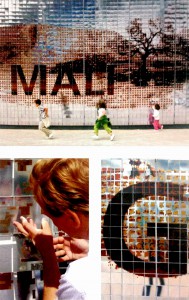
Steppe, savannah, prairie, Saragossa
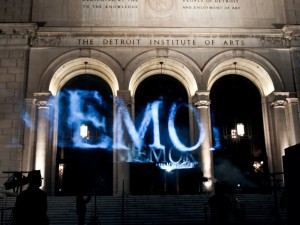
Memory Cloud Detroit, Minimaforms
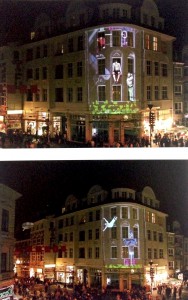
Jump, Bremen
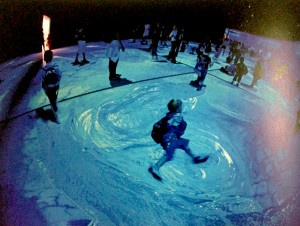
Water Zone, Acciona Pavilion, Saragossa
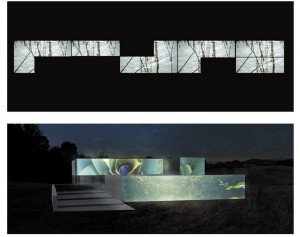
Lighthouse, Doug Aitken
The project aims towards an informational material interface, which can inform, entertain, advertise… the modes and systems of interactivity is my focus, involving the issues of demographic data, mobility of people, their direct interaction with material interfaces. The thesis seeks to define the thesis as between, not a gallery project, and also not an urban scaled media facade, by working on the architectural and urban repercussions of cinematic media, new smart materials, and the interaction with a populace in public civic space.
My design project is cultural and festive in nature, when an atmosphere is important. The design hybrid, where the relationship between the presenter and the receiver will be parallel and mutual. A new prototype, the 4Dx, happens when the real human sensations and the virtual imagination and space come into mutation – the x factor.
The type of media that architecture represents has changed over time. From book to screen, and then to film, to cinema… in these stages the facade is a key element for investigation. The facade has connection with human’s senses or minds when it is close to users, as well as when it is far away. The impact and the degree of stimulation is different for different distances, but the connection remains. The type of connection is the question, whether it is mental, visual, physical, conceptual, virtual.
WHY?
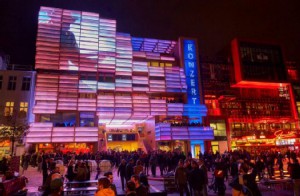 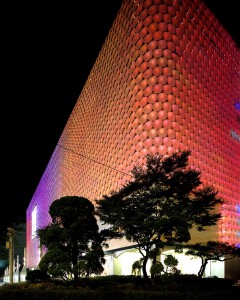
Klubhaus St.Pauli, Hamburg UN Studio’s galleria project, Seoul
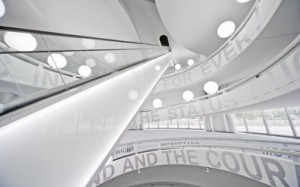 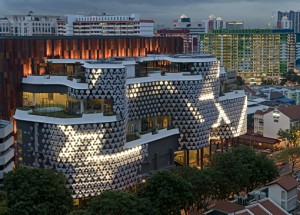
BMW Museum, Altelier Bruckner Iluma Building, Singapore
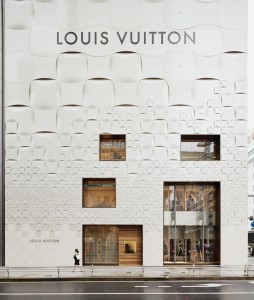 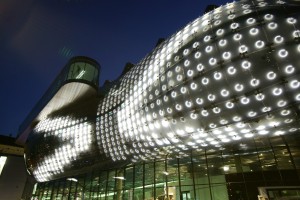
Louis Vitton, Ginza Kunstahall, Graz
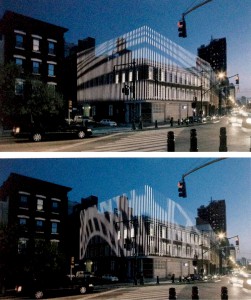
Chelsea Art Museum, New York
My concept of architecture as book can be illustrated in “Notre-Dame de Paris”, where Hugo expressed his idea of “Architecture is the great book of humanity”. Before the invention of printing press, architecture acted as a medium to mediate virtual texts – concepts. For architecture as screen, I will use Robert Venturi’s projects as reference, the Vanna Venturi House and his theory of “shed” and signboard architecture in “Learning from Las Vegas”. While architecture as film can be seen in Bernard Tschumi’s projects. The cinematic strip of gardens and the implementation of “Manhattan Transcript” in his Parc de la Villette shows the focus on the events instead of space, which comes naturally as a consequence. I categorize the above as 2D because of the passive relationship between architecture (presenter) and users (receiver).
While the evolution to 3D and 4D (architecture as cinema) is different, in which the audience is not isolated but involved in the design itself. The “light belt” as Elizabeth Diller described, that creates a “seamless continuity that connects the audience with performers”, in her Alice Tully Hall, as well as the Slow House which I see as a cinema where the audience walks instead of sits.
Over the past 10 years, multimedia arts has been merging with architecture, which inspires my concept of going beyond 4D – a 4Dx. Existing examples of concepts between 4D and 4Dx include Pipilotti Rist’s Pour Your Body Out in the Museum of Modern Art; Doug Aitken’s Lighthouse, and his Song 1 installation at Hirshhorn. The idea of virtuality has been put into experimentation. John Welling’s Glass House Series is a vivid example of reflections being the building materials, and the surrounding projections turn an empty space into a large structure of landscape, buildings and sculptures.
Over the last decade, media involved in or on buildings has been a popular way for branding and advertising. The BMW Museum where the facade illumination changes according to the presence of visitors as well as communicate texts, Kunstahall’s pixelized media facade, Iluma Building’s exterior with its tessellated pattern which establishes itself as a landmark, Chelsea Art Museum where the media effects change the virtual form of the building, Klubhaus St Pauli where the media merges with its form, the UN Studio’s galleria facade which reflects the dynamics of the weather conditions of the day etc. In parallel, there are also many projects using material effects for commercial branding, for example Prada, HdM, Tokyo, and Louis Vitton, Ginza. But there is still no existing project that focus on integrating material effect with media light effects and illumination.
HOW?
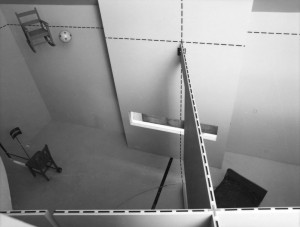
The Withdrawing Room, Elizabeth Diller
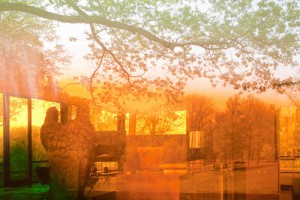
The Glass House, James Welling
A series of experiments across “dimensions” will be carried out, to investigate principles and develop the potentials of a 4Dx media “dimension” of architecture, where actual space design is not the focus, but generates a new realm of concept of space.
Step 01: Research on graphic space (2d, graphic, typographic), and material effects, and from that develop new material effects integrated with graphic space
Step 02: Develop a set of notations, in drawings, models and animations, to describe events and space when architecture is a “cinema” but not just “film”, when the senses of audience are stimulated. Compare and contrast these drawings or models of 3D and 4D with the 2D Manhattan Transcripts. (Test site: Facade Format: Drawing/model notations/animations Types of medium: Light and sound)
Step 03: Develop a design of cinematic media and alternatives to the urban application of media to facades for advertising and branding, with reference to the Withdrawing Room and Slow House, which acts as a cinema that stimulates the five human senses, as well as human movement. (Test site: Public civic space Format: Drawdel plus animation Types of medium: Stimulations of the five human senses)
Step 04: Final tests, simulations of how 4Dx can perform. In the format of a movie and a model.
Bibliography
Theory:
Victor Hugo, Notre-Dame de Paris, (Hachette, 1994)
Robert Venturi and Denise Scott Brown, “A Significance for A&P Parking Lots, or, Learning from Las Vegas”, Architectural Forum 128, no. 2 (March 1968), 36-43.
Denise Scott-Brown, “Learning from Pop,” Casabella 359-360 (December 1971), republished in K. Michael Hays, ed., Architecture Theory since 1968 (Cambridge:MIT Press, 2000), 440-461.
Bernard Tschumi, Interview by Yoshio Futagawa, (Tokyo, Japan: ADA Edita Tokyo, 1997)
Haeusler, M. Hank. Media facades : history, technology, content. Ludwigsburg : avedition, 2009.
Bernard Tschumi, The Manhattan Transcripts, (London: Academy Press, 1994)
Henri Bergson, Matter and Memory, (Cambridge: MIT Press, 1996)
Techniques:
The Slow House, Elizabeth Diller
The Withdrawing Room, Elizabeth Diller
The Glass House, James Welling
Projects:
Bernard Tschumi, Event-cities 2, (Cambridge: MIT Press, 2000)
Sylvia Lavin, Kissing Architecture, (Princeton University Press, 2011)
Media facades : history, technology, content / M. Hank Haeusler with a foreword by Tom Barker.
Other Projects:
The Louvre Abu Dhabi Museum, Ateliers Jean Nouvel
Galleria Centercity, UNStudio
ABC Department Store, nARCHITECTS
Minimaforms, Stephen and Theodore Spyropoulos
Prada, HdM, Tokyo
Louis Vitton, Ginza
|